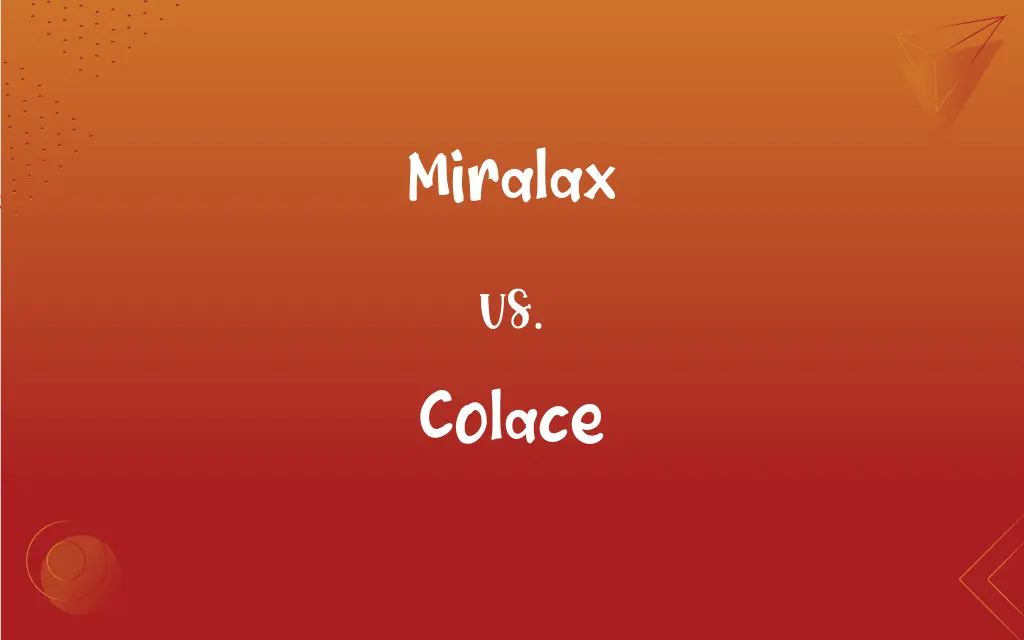Miralax vs. Colace: What's the Difference?
Edited by Janet White || By Harlon Moss || Updated on October 3, 2023
Miralax is an osmotic laxative increasing water content in stools, while Colace is a stool softener helping stool pass more easily.

Key Differences
Miralax, categorized as an osmotic laxative, operates by pulling water into the intestines to help facilitate the movement of bowel contents. Differently, Colace, defined as a stool softener, focuses on easing the passage of stool by increasing its water content, thereby preventing hard stools that are difficult to pass. Miralax provides a mechanism that enhances the water content within the stool itself, while Colace acts to make stool passage smoother and potentially less painful.
In medical contexts, Miralax is often utilized for its effectiveness in dealing with constipation through osmotic activity. Conversely, Colace typically finds its application in preventing constipation, particularly in instances where straining during bowel movements should be avoided, such as post-surgery. Miralax’s ability to retain water within the bowel facilitates easier passage of stool, while Colace ensures that the stool remains sufficiently soft.
The active ingredient in Miralax, polyethylene glycol 3350, plays a pivotal role in its osmotic action. Meanwhile, Colace, containing docusate as an active ingredient, introduces a surfactant action that enhances water and fat incorporation into the stool. The distinct active ingredients highlight a chemical differentiation between Miralax and Colace, underlying their diverse operational mechanics in alleviating constipation.
Miralax is often recognized for its general use in addressing issues of occasional constipation, enabling more regular bowel movements. Colace, in contrast, is commonly recommended for situations requiring avoidance of straining, such as during certain medical conditions or post-operative periods. Miralax typically produces a bowel movement within 1 to 3 days, whereas Colace might be employed in a preventative capacity.
In terms of usability, Miralax usually comes in a powder form that is mixed with a beverage for consumption. Colace, alternatively, is generally available in liquid, capsule, or enema forms, offering a range of application methods for diverse patient requirements. The distinct physical forms of Miralax and Colace offer varied modes of administration, catering to patient and caregiver preferences and necessities.
ADVERTISEMENT
Comparison Chart
Type of Laxative
Osmotic laxative
Stool softener
Usage
Treats constipation
Prevents constipation
Active Ingredient
Polyethylene glycol 3350
Docusate
Typical Form
Powder to be mixed
Capsules, liquid, or enema
Time to Take Effect
1-3 days
Might be used preventatively
ADVERTISEMENT
Miralax and Colace Definitions
Miralax
Typically comes in a powder form.
Miralax can be mixed with your favorite beverage.
Colace
A type of stool softener.
Colace is often used to prevent constipation.
Miralax
Contains the active ingredient polyethylene glycol 3350.
The efficacy of Miralax is due to polyethylene glycol 3350.
Colace
Available in various forms including capsules.
Colace capsules are an easy-to-swallow option for preventing constipation.
Miralax
An osmotic laxative medication.
Miralax helps to relieve occasional constipation.
Colace
Helps prevent straining during bowel movements.
After surgery, Colace may be used to minimize straining.
Miralax
Can produce a bowel movement in 1-3 days.
After taking Miralax, expect a bowel movement within a few days.
Colace
Contains the active ingredient docusate.
The stool-softening action of Colace is due to docusate.
Miralax
Increases water content in stools.
Miralax works by drawing water into the intestines.
Colace
Commonly used in post-operative care.
Post-surgical patients might use Colace to facilitate gentler bowel movements.
FAQs
How is Miralax typically administered?
Miralax comes in powder form and is usually mixed with a beverage before consumption.
How are Miralax and Colace different in action?
Miralax works by pulling water into the stool, while Colace softens stool to make it pass more easily.
Can Miralax and Colace be used for children?
Yes, but always consult a healthcare provider before giving any laxative to children.
What is Miralax commonly used for?
Miralax is used to treat occasional constipation by increasing stool water content.
Can Colace be used for dogs?
Veterinarians might recommend Colace for dogs in certain circumstances; always consult them first.
Is it possible to overdose on Miralax?
Yes, overdose is possible and in such cases, urgent medical attention should be sought.
What is a common dosage of Miralax for adults?
A common adult dosage is 17 grams of Miralax powder per day, but always adhere to provider recommendations.
In what forms is Colace available?
Colace is available in liquid, capsule, and enema forms.
Is it safe to use Colace regularly?
Long-term use of Colace should be discussed and approved by a healthcare professional.
Is Miralax suitable for long-term use?
Chronic use of Miralax should be monitored and advised by a healthcare provider.
Can Colace cause allergic reactions?
Though rare, Colace can cause allergic reactions and immediate medical attention should be sought if this occurs.
Are there any dietary restrictions while using Miralax?
There are no specific dietary restrictions, but a healthcare provider might suggest dietary changes to manage constipation.
Can Colace interact with other medications?
Yes, Colace can interact with certain medications, so a healthcare provider should be consulted.
How does Colace work to prevent constipation?
Colace acts as a stool softener, helping to prevent constipation by enabling easier passage of stool.
How quickly does Miralax typically produce a bowel movement?
Miralax generally produces a bowel movement within 1 to 3 days.
What is the primary ingredient in Colace?
Docusate is the active ingredient in Colace.
Can pregnant individuals take Miralax?
Consultation with a healthcare provider is crucial before taking Miralax during pregnancy.
Can Miralax and Colace be used simultaneously?
It's vital to consult a healthcare professional before combining any medications.
How should Miralax be stored?
Miralax should be stored in a cool, dry place away from direct light.
What are potential side effects of Colace?
Colace can cause side effects like stomach cramps, diarrhea, or throat irritation.
About Author
Written by
Harlon MossHarlon is a seasoned quality moderator and accomplished content writer for Difference Wiki. An alumnus of the prestigious University of California, he earned his degree in Computer Science. Leveraging his academic background, Harlon brings a meticulous and informed perspective to his work, ensuring content accuracy and excellence.
Edited by
Janet WhiteJanet White has been an esteemed writer and blogger for Difference Wiki. Holding a Master's degree in Science and Medical Journalism from the prestigious Boston University, she has consistently demonstrated her expertise and passion for her field. When she's not immersed in her work, Janet relishes her time exercising, delving into a good book, and cherishing moments with friends and family.
































































